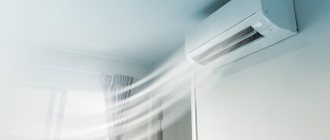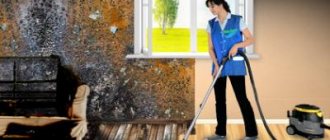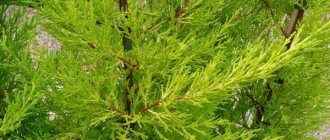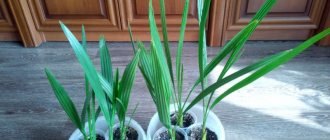With the onset of cold weather, people spend most of their time in heated rooms. It is warm and dry here, sometimes even excessively. The optimal level of indoor air humidity is 40–60%, but with the beginning of the heating season it drops to a catastrophically low level of 25–30%. Sometimes these numbers can be even lower. Dry air in an apartment is very harmful to human health, household and computer equipment, pets and plants. Many allergies and colds are the consequences of an uncomfortable microclimate in the apartment. Factory-made humidifiers are expensive, and not everyone can afford them. Then the question arises: what to do, how to humidify the air in the room yourself?
Wet cleaning
Many housewives feel that in winter there is less dust and dirt, they begin to clean less often or give preference to dry types of cleaning. However, this is the wrong approach - wet cleaning will not only get rid of dirt and dust, but will also help to humidify the air in the apartment. The water is distributed in a thin layer over a large area, causing the humidity level to rise in all rooms.
Wet cleaning kills many harmful microbes (especially if detergents or disinfectants are used with water), mold spores, and dust mites.
The only downside is that cleaning takes quite a lot of time.
How to reduce humidity in your home in winter
Humidity more than 80% is called dampness, and it is no less dangerous to health than its deficiency. Can provoke diseases such as tuberculosis, rheumatism, bronchial asthma, eczema. During the winter season, increased humidity in the house can cause fungus to appear on the walls, corners and ceiling. Identify the source of the excess moisture. The reason may be various factors:
- frequent washing, cooking;
- freezing of walls;
- poorly installed windows;
- disruption of ventilation or its absence;
- damp basement;
- insufficient heating.
Do not delay in eliminating the problem of high humidity, otherwise you will cause serious damage not only to your health, but also to household items, furniture, and clothing. In the future, this will lead to unplanned repairs, and the unpleasant smell will remain in the room for a long time.
- Open windows more often when drying clothes, cooking, and after taking water procedures.
- Leave the windows uncovered to allow daylight in, especially in bright sunny weather, this will quickly eliminate the feeling of dampness.
- In rooms with high humidity levels (kitchen, bathroom), install a high-quality ventilation system.
- If necessary, use additional heating means (oil radiators, air conditioning systems).
- Purchase a specialized device - an air dehumidifier. There are two types: stationary and portable. They differ in the installation method; the stationary one cannot be moved, unlike the portable one. And here’s another useful article on how to reduce air humidity in an apartment
Ventilation of rooms
Changing the air in the room is the simplest, most hygienic and requires neither time nor effort. However, its level of effectiveness is low. Thus, the air in the room is well humidified in rainy, damp weather, while in summer and winter, when it’s cold, the air outside is also dry. With regular ventilation, the humidity level rises by several percent, the air in the room is refreshed and ventilated. This is an effective method of combating various bacteria and harmful microorganisms that thrive in dry microclimates and do not like water.
How to reduce humidity
High humidity is not always a good thing. If mold, mildew appears on the walls, or condensation constantly collects, it must be reduced. You can use one of these methods:
- Dehumidifiers. Special devices absorb excess water molecules, taking air from the room. The principle of operation of such a device is based on the condensation of steam in the room. The air conditioner performs part of the functions of a dehumidifier - it also takes water from the air.
- Good ventilation. Clogged air ducts do not cope with the function of removing excess wet air from the apartment.
- Drying clothes outside or on the balcony. When drying, the fabrics release water molecules into the air, which circulates throughout all rooms and increases humidity.
- Sunlight. When it enters a room, it causes water to evaporate, so it is recommended to open windows regularly.
Some factors that increase humidity cannot be influenced:
- the more people live in an apartment, the lower this figure will be;
- if all the windows face north, the rooms most often have dampness;
- In some cities, climatic conditions determine constant high humidity.
Water containers for air humidification
A very simple option for humidifying the air in a room: you can place basins or vases with water throughout the apartment. The water will evaporate, and the level of air humidity will increase due to this. You can show your imagination and place around the house not just basins of water, but original decorations. For example, decorate an ordinary jar or bottle, place a composition of stones, shells inside, put a small decoration for an aquarium in the container, etc. When using this method of moisturizing, you must remember the following:
- The water must be changed regularly, and the vessel itself must be washed periodically, as dirt accumulates in it. Plaque forms on the walls and bottom, and sediment accumulates. All this needs to be removed.
- You need to monitor the water level and add liquid in a timely manner; in dry rooms it evaporates into the air very quickly.
- Vessels with water should be placed in places where they will not be dropped or overturned. You need to be especially careful if there are children or pets in the house.
USEFUL INFORMATION: How to get rid of condensation on the toilet tank
You can add a few drops of essential oil to vessels with water, and the air in the rooms will become fragrant. To increase the efficiency of this method, you can place water tanks on the battery - then the water will evaporate faster.
Device with carbon filter
The carbon filter purifier is great for indoors - it helps maintain health and is the most inexpensive air purification equipment on the market. You can make such a device yourself - it will do an excellent job of getting rid of unpleasant odors, for example, tobacco.
Let's look at the manufacturing process.
We cut the outer pipe (diameter 200/210 mm) to 77 mm, and the inner pipe (150/160 mm) to 75 mm
Please note - all burrs must be removed
- We sew the mesh with a slightly curved needle with a thread threaded into it (the main thing is that it is sewn along the entire length). As you sew, move the clamps (they are for convenience).
- Excess agrofibre and mesh (protruding) are removed with suitable tools - the mesh with nippers, and the fiber with ordinary scissors.
- The main thing is not to forget that first the pipe is wrapped in mesh and then in fiber.
- We fix the edges with aluminum tape.
- We insert the inner pipe into the plug so that it is directly in the center, using spacers from the circles that were drilled out. After this we do foaming.
The air purifier is ready! After the material has dried, insert a duct fan into the adapter.
In order to clean the air in your home, it is not at all necessary to buy ready-made, expensive devices. Making one of the designs at home is not at all difficult. The efforts spent will definitely pay off with favorable well-being and health.
See below for more details.
Aquarium with water as a humidifier
If you have had a desire for a long time, then you can get fish. Water from the aquarium also evaporates, just like from any other container. At the same time, the air in the rooms is humidified. However, in this case there will be more worries and troubles: regular cleaning, caring for the fish, buying special food, and the necessary equipment is not cheap. On the other hand, watching fish calms the nerves; interaction with the living world has a beneficial effect on children. However, you need to understand that a small aquarium is unlikely to sufficiently humidify the air in the entire apartment.
Fountain in the apartment
Another variation on the theme of a water container. This is the most effective way to humidify the air. It works on the following principle: water is poured into a special reservoir, the device is connected to the network, and the liquid begins to circulate in a circle. This fountain humidifies the air well, makes the indoor microclimate more favorable and decorates the interior.
There are a huge number of design options for water fountains. You can limit yourself to a desktop model or purchase a larger product. But you need to take into account that the water in the fountain is constantly gurgling. This sound calms some people, while others, on the contrary, irritate them. In the latter case, buying a fountain would not be the best idea.
Method 7 – home humidifier
Home craftsmen offer two options for home humidifiers:
1. Bandage moisturizer:
- Place a bowl or jar of water on the floor;
- Hang a bandage or piece of fabric folded in several layers on the battery. Its end should hang into a container of water.
The bandage will absorb water, and the warm battery will evaporate it.
2. Humidifier from a plastic cup:
- Cut a cup with a tail from a plastic bottle or tin can;
- Attach it to a pipe near the battery and fill it with water.
Or you can tinker a little and make a humidifier like this:
Houseplants humidify the air
Indoor plants will help solve the problem of excessively dry indoor air. In this case, water evaporates from several sources: from the ground in the pot after watering, from the stand under the pot if liquid gets there, and from the leaves of the flowers themselves. Thanks to a home garden, you can constantly maintain air humidity at an optimal level. Plants with large leaves, such as ficus or philodendron, are especially good for this. Cyperus is a record holder for water evaporation: it can release up to 3 liters of moisture through its leaves. Flowers also filter the air well; many saturate it with useful substances and fight harmful microorganisms.
Plants can be used as a home hygrometer: if the air in the apartment becomes too dry, the edges or tips of their leaves begin to dry out.
Of course, there is a lot of hassle with an indoor greenhouse: you need to take care of it, water it in a timely manner, prune it, replant flowers, fertilize the soil, treat it against pests, and so on. On the other hand, you can choose unpretentious plants, for example, fat plants and other succulents, which can survive for a long time without watering, while they are quite capable of humidifying the air at home. This is a very convenient option for those who are often away from home. Chlorophytum, aloe or pike tail are very undemanding to external conditions; they can take root even in the most forgetful owner.
USEFUL INFORMATION: What is an anemostat?
Flower drinkers are often used at home. Water flows out of these reservoirs in portions, which also helps to increase the level of air humidity in the apartment.
How to increase air humidity with household appliances
The most affordable and popular device for increasing humidity in the air is a household humidifier. It can be used all year round, but it will be especially useful in winter, when indoor humidity of 20 percent causes discomfort.
The following types of humidifiers are available:
- Classic. The operating principle of such devices is based on the evaporation of cold water without preheating. Water flows from a special container onto the evaporator - disk, filter or cartridge. Due to the fact that such devices take air from the room and release it after cleaning with a filter, additional removal of dust and allergens occurs.
- Humidifiers with air purification function. These are full-fledged climate control devices that simultaneously increase the level of humidity and purify the air by equipping them with special replaceable filters. They are also called air washers.
- Steam models. The operating principle of such devices is similar to the operation of an electric kettle. Heating elements with a ceramic plate or coil release steam after preheating the water. It is optimal to use both in summer and to maintain humidity levels in the apartment in winter.
- Ultrasonic. The most expensive and effective. The liquid poured into the reservoir flows onto a plate that vibrates under the influence of ultrasound. The water breaks up into tiny droplets, which enter the room through a cooler inside the case.
Drying clothes indoors
Drying clothes is an excellent solution to the question of how to humidify the air in an apartment without a humidifier. Moreover, this method does not require additional effort: all people wash things periodically. They can be dried at home, not outside. A lot of water evaporates from the laundry, so the air humidity level in the apartment will quickly return to normal. To speed up the process, you can hang your laundry on radiators. If you add conditioner when washing or use powder with a pleasant smell, then the rooms will always have a light, pleasant aroma.
How to measure humidity
There are several ways.
- Use a hygrometer. This is a special device designed to measure humidity. Now there are a variety of types on sale (mechanical and electronic). If you want to use it for household purposes, you can buy the simplest and cheapest option.
- Experiment with a glass. A folk method that works as follows: fill a glass with cold water and put it in the refrigerator for 2-3 hours. The water should cool to 3-5 ºС. Then take out the container and leave it in the room, but away from the battery, otherwise the experiment will not be clean. Watch. If after some time the surface of the glass becomes foggy, but dries very quickly, this is a sign of excessive dryness. If there is too much condensate and it flows along the walls, this indicates increased dampness, which also needs to be dealt with. And if during the same period of time the surface did not dry out, but did not flow, then the humidity level is normal.
If the instruments show minimum parameters, you must definitely humidify the air in the apartment; this is not difficult to do with your own hands. If you neglect and leave it dry, health problems and other troubles may arise.
Ventilation of the bathroom
The wettest room in any apartment is the bathroom. Here they are constantly doing something with water: washing, washing, taking a shower, etc. Because of this, the level of air humidity in the room is very high and reaches 80–90%. Why not use this for the benefit of the entire apartment? Airing the room for 10-15 minutes after taking a bath will prevent mold and mildew from appearing in the bathroom and will raise the humidity level throughout the apartment by several percent. You can also leave the door open while hand washing or washing.
Relative humidity according to GOST
Microclimate parameters in living rooms are specified in GOST 30494-2011. They are classified into optimal and acceptable.
An optimal microclimate is one in which the human body is able to maintain a normal thermal state without undue stress on the thermoregulatory mechanisms. With an optimal microclimate, about 80% of people in the room feel comfortable. But the remaining 20% will be uncomfortable.
With acceptable microclimate parameters, the body’s thermoregulation mechanisms are strained, which is why a person’s well-being worsens, he feels discomfort, but without harm to health.
Let us clarify that these standards were developed for builders and organizations servicing residential buildings (housing offices, homeowners' associations, etc.). Therefore, microclimate parameters are indicated in relation to the cold and warm periods of the year. That is, builders must build houses so that they maintain heat and humidity at an acceptable level, and service organizations ensure sufficient heat supply in winter.
To obtain data on the humidity level, a hygrometer is enough, but all microclimate parameters are important for health; a home weather station will help you control them
But interrelated indicators of temperature and relative air humidity are important for the human body, regardless of the time of year. What they should be is shown in the table.
| Optimal air temperature | Optimal relative humidity | Maximum permissible relative humidity |
| 20-22 °C | 45-30% | no more than 60% |
| 22-25 °C | 60-30% | no more than 65% |
As you can see, the range of parameters is very wide and when the temperature rises by only 2-3 °C, the upper limit of optimal humidity immediately “jumps” up. It is clear that, despite the standards, an increase or decrease in humidity by 1.5-2 times at a constant temperature will affect well-being.
Even when approaching the lower limit of normal, the air is perceived by many as too dry. If the temperature outside remains −20 °C or lower for a long period, then the relative humidity in apartments drops below the maximum level and can reach 5-7%.
Sprayer for air humidification
Something as simple and cheap as a spray bottle can help solve the problem of excessively dry air. You can simply spray a little water into the air - small drops will collect dust and imperceptibly settle on the floor along with it. You can also spray water on curtains and tulle. Moisture will evaporate from the fabric gradually, due to which a relatively constant level of air humidity will be maintained in the room. However, before using the proposed method, you need to make sure that there are no stains left on the curtains from drops and splashes. Otherwise, the products may lose their appearance.
USEFUL INFORMATION: Making your own air purifier
A spray bottle is also used to spray plants with water. This procedure will clean the leaves from dust and moisten both them and the air.
What can a lack of proper humidity cause?
The human body has a fantastic ability to adapt to any conditions. That is why people populated all areas of the Earth - from dry deserts to the humid tropics and the equatorial zone. But this does not mean that all conditions are equally beneficial and do not harm the body. Low humidity causes many health problems.
Respiratory system diseases
Dry air, entering the bronchi and lungs, dries out the epithelium and causes a severe cough. The protective functions of the epithelial membranes are lost, bacteria and viruses multiply rapidly, causing diseases of all parts of the respiratory system.
The appearance of a runny nose, sinusitis and sinusitis
Lack of moisture leads to drying of the mucous membranes of the nasal passages and disruption of the natural microflora. Rhinitis, sinusitis and sinusitis of an allergic nature develop.
Inflamed mucous membranes become fertile ground for the development of bacterial, fungal and viral diseases of the nose.
Rapid skin aging
Evaporation of moisture from the skin, with a lack of humidity, occurs especially quickly. The skin becomes rough, covered with hangnails, and peels off. Many people experience itching and the epidermis becomes inflamed. Dry skin provokes rapid aging and the appearance of wrinkles.
Hair is dull and brittle
Hair and scalp react quickly to dry air. Lack of moisture makes hair dull, it breaks faster, becomes electrified, and ends split.
Allergic reactions
Water vapor in the air binds dust and makes it less volatile. It does not penetrate the respiratory tract so quickly. When humidity is low, people are more likely to develop allergic reactions to various air components. Dry air is especially dangerous for people with allergic asthma.
Decreased immunity
The skin and mucous membranes are the natural defense of the entire body. They meet all pathogenic microorganisms and prevent their penetration inside. At low humidity, not only local, but also general immunity is lost. In addition, lack of moisture leads to the rapid proliferation of some infectious agents in enclosed spaces.
All kinds of eye problems
The mucous membranes of the eyes lose moisture, the eyes often turn red and get tired quickly. Allergic conjunctivitis is accompanied by infectious conjunctivitis. Wearing contact lenses turns into torture - they dry out, discomfort and burning are felt in the eyes.
Important: the most dangerous consequences of low humidity for the body are lack of oxygen, increased fatigue, and difficulty with the heart.
Wet towels versus dry air
If laundry is not dried in the apartment often, and water stains form on the curtains, then you can do it differently: use wet towels. To do this, they are moistened under the tap, wrung out so that no water drips, and hung on heating radiators. As it dries, the procedure is repeated. It is better to use terry towels, as they hold more water and will take longer to evaporate it into the air.
Improvised air humidifier
Running around with towels can quickly get boring, so you can do the following: make a small installation from scrap materials that will humidify the air. To do this you will need a plastic bottle, a piece of fabric made from natural materials (cotton, linen) or gauze, a rope, a knife and water. How to make such a device, step by step:
- A small hole-window is cut out on the side of the bottle.
- The bottle is tied to a radiator or heating pipe.
- One end of the gauze or piece of cloth is dipped into the bottle, the other is wrapped around the pipe.
- Pour water into the bottle.
That's it, the improvised humidifier is ready. Water will rise up the fabric and quickly evaporate into the air thanks to the heated radiators.
As you can see, there are many ways to humidify the air in an apartment. This can be done regardless of the season, but in winter, when the heating is on, some methods become especially effective. Air humidification does not require much effort or large expenses. At the same time, you will be able to avoid many health problems: allergies, rhinitis, dry and flaky skin - all these are consequences of low indoor humidity levels. As a result, the skin and mucous membranes dry out and cannot fully perform their functions. Lack of water is also detrimental to pets, office equipment, many valuable trinkets, books and various household items. So you need to take care of the microclimate in your home, especially since it doesn’t cost anything.
Dependence of air humidity on season
The influence of the change of seasons on the level of humidity in the apartment is clear, but it would be more correct to talk about the influence of the heating season in the city.
In summer, early autumn and late spring , when central heating in houses is turned off, the indicators approach normal without any additional adjustments. The high temperature outside, coupled with constant ventilation, creates an ideal indoor atmosphere. In extreme heat, the indicator may exceed the permissible norm and then you will have to resort to lowering the humidity using air conditioning or other means.
On the contrary, in the winter months , when the radiators begin to warm the air in the apartment, and the windows are opened less and less often, the indicators can drop to 10-15%. That is why during this period it is important to constantly monitor the level of humidity and, if necessary, increase it independently to normal using special devices or resorting to folk methods and improvised means.











